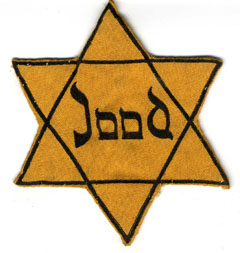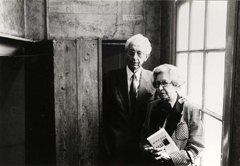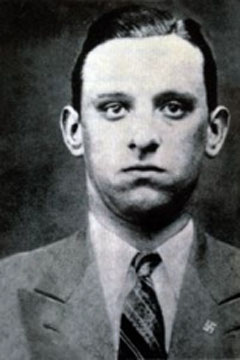
The Star of David that all Jews had to wear. This one belonged to either Margot Frank or Mrs. Stoppelman, the former landlady of Miep Gies.It was not long after Otto Frank had asked four of his closest colleagues at the office whether they would be willing to assist his family and Hermann, Auguste and Peter van Pels if they were to go into hiding in the rear annex of the office building at Prinsengracht, that Margot Frank was summoned to report for the Arbeidseinsatz (work duty), in early June 1942. Immediately the Franks decided that now was the time to go into hiding. Miep and Jan went to the Frank family to help them prepare for their disappearance. ‘When we arrived at the Frank apartment, few words were exchanged. I could feel their urgency, an undercurrent of nearpanic. But I could feel their urgency, an undercurrent of nearpanic. But I could see that much needed to be organized and prepared. It was all too terrible.' Jan and Miep took as many clothes and shoes as possible to their own home, so that these could be brought to the Secret Annex at a later date.
The next morning, on Monday July 6, 1942, Miep went by bicycle to meet Margot at Merwedeplein, as planned. It was pouring rain. Margot mounted her own bicycle and together they rode off in the direction of the city center, like two colleagues on their way to work. They did not speak a word as they went, but steadily cycled along. They both realized that they had transformed from ordinary citizens into criminals. Miep was accompanying a Jewish girl, cycling on an illegal bicycle without a Star of David on her sleeve, on her way to go into hiding. Margot seemed as calm as ever, her face betrayed nothing. They had become accomplices, opposing the German occupiers. 
Miep and Jan Gies in the Secret Annex, next to the bookcase that hid the entrance to the Secret Annex, around 1988As soon as they arrived at the office, Margot disappeared through the door leading to the Secret Annex, and Miep sat down at her desk. One after the other her colleagues arrived, just like any other day at the office. Later that morning Otto, Edith and Anne came in, drenched by the rain. Miep received them and took them to the hiding place. In the afternoon Miep joined them there. ‘The situation was very upsetting. I wanted tot leave the family alone together. I couldn’t begin to imagine what they must be feeling to have walked away from everything they owned in the world – their home; a lifetime of gathered possessions; Anne’s little cat, Moortje. Keepsakes from the past. And friends. They had simply closed the door of their lives and had vanished from Amsterdam. Mrs. Frank’s face said it all. Quickly, I left them.' Click here for a video excerpt in which Miep Gies recounts the first day in hiding.
One week after the family Frank went into hiding, they were joined by Hermann, Auguste and their fifteen-year old son Peter van Pels. They took up residence in the upper floor of the Secret Annex, while the Franks shared the lower floor. In November 1942 an eighth person joined them, the dentist Dr. Fritz Pfeffer. From that moment he shared a room with Anne. Pfeffer was an acquaintance of the Frank and Van Pels families. Miep and Jan also knew him from the Saturday afternoons at the Frank home at Merwedeplein. Since several years he was also Miep's dentist. Hermann van Pels had been working in Otto Frank's company since 1938, so Miep and Jan knew him well. They had also gotten to know his wife through the Saturday afternoons at Merwedeplein.
The helpers, without whom the hiders could never have gone into hiding, were Miep Gies, Victor Kugler, Johannes Kleiman and Bep Voskuijl. Miep's husband Jan and Bep's father Johan had also pledged their unconditional help to the hiders. Aside from Jan they all worked at the office of Otto Frank. In fact, officially Jan was also part of the company, as Otto Frank had formally resigned as executive director of the company in December 1941, and Jan had become a commissioner of Pectacon, the firm's spice branch. Pectacon would henceforth be called Gies & Co. Victor Kugler was appointed executive director and Johannes Kleiman became managing director of the Nederlandsche Opekta company. All of the company staff were on very friendly terms with each other. Otto Frank would continue to run the company from the Secret Annex. 
October 1945, Otto Frank seated in the middle with Miep Gies and Johannes Kleiman on the left, and Bep Voskuijl and Victor Kugler on the right.The tasks were divided among the four helpers: Miep Gies and Bep Voskuijl took care of the daily grocery shopping. Every morning, before the others arrived at the office, Miep went to the Secret Annex to collect the shopping list for that day and to see how things were going. During the day she went shopping at the vegetable store and the butcher while Bep took care of bread and milk, which she brought to them during the lunch break. She would then have lunch with the Secret Annex occupants, telling them the latest news about the world outside. Every Saturday Miep brought them five library books. Johannes Kleiman and Victor Kugler looked after the safety of the hiders and arranged all the financial aspects. Thanks to his contacts at the municipality and with the National Organization for Assistance to Divers, Jan Gies was able to obtain ration cards. Bep's father Johan, the foreman of the stockroom at Prinsengracht, devised and built the swiveling bookcase that hid the entrance to the Secret Annex.

Anne Frank's diary. Source: website entoen.nuOn January 28, 1944, Anne Frank expresses her amazement at the fact that there are so many noble people, selflessly helping and saving other people: ‘The best example of this is our own helpers, who have managed to pull us through so far and will hopefully bring us safely to shore, because otherwise they'll find themselves sharing the fate of those they're trying to protect. Never have they uttered a single word about the burden we must be, never have they complained that we're too much trouble. They come upstairs every day and talk to the men about business and politics, to the women about food and wartime difficulties and to the children about books and newspapers. They put on their most cheerful expressions, bring flowers and gifts for birthdays and holidays and are always ready to do what they can. That's something we should never forget; while others display their heroism in battle or against the Germans, our helpers prove theirs every day by their good spirits and affection.'

A so-called ‘ration stamp’ which entitled people to a small amount of food (meat, bread, butter). This one dates from October 1944.
As the war dragged on, it became increasingly difficult to obtain the daily groceries for the eight hiders and for Jan and Miep as well. Since the spring of 1943, Jan and Miep also had a Dutch student in hiding in their own home on Hunzestraat. This student had refused to sign the German oath of allegiance, imposed on all students. To avoid being arrested and deported to Germany, he had to go into hiding and had found a safe place in Jan and Miep's home. This means that Miep had to go shopping every day for eleven people in total. Less and less was available, so the range of choice diminished accordingly. She felt like a hunter, continually on the prowl for her 'ever-hungry nestlings'. 'But slowly, I was turning into an unrelenting scavenger, and would make do even with scraps. I could not allow myself to get sick. I could not allow myself a holiday.'
It also became harder and harder to only bring positive news to the Secret Annex. By coincidence, Miep had seen the Van Pels family home cleared out by a moving company, on German orders. Miep had brought this piece of news to the Secret Annex, but it had upset Mrs. Van Pels so deeply that Miep decided to only bring neutral or positive news. ‘This wasn’t easy to do. Anne would have made a great detective. She’d sense that something was being withheld and she’d pull and squeeze, probe and stare me down, until I’d hear myself revealing just what I had decided not to reveal.' Miep also felt a bit uneasy sometimes about the unequal relationship that had grown between the helpers and the hiders. The hiders had put their lives entirely in the hands of the helpers, and that absolute dependency sometimes weighed down on her. Click here to see a video excerpt in which Miep talks about this.
Aside from the fear of discovery and arrest, the main fear of the hiders and helpers alike was to become ill. During office hours, the residents of the Secret Annex had to be as quiet as a mouse, as the stockroom assistants, for example, knew nothing of their presence. If one of the hiders were to catch a serious cold, the coughing and sneezing could well compromise their safety. A doctor's visit was out of the question of course, let alone any kind of operation. If one of the helpers were to fall sick, the other helpers would have to take over his or her tasks. November and December 1943 brought much anxiety: Miep, Bep, Mr. Kleiman and Anne all fell sick. Fortunately, the situation was not drastic and toward the end of the year everyone was feeling better. Mr. Kugler, Mr. Kleiman, Bep, Jan and Miep celebrated the Friday before New Year's Eve in the Secret Annex. With some saved scraps of butter and flour, Miep had baked a spice cake. ‘The sight of our parade was like an elixer of pleasure. Before us, eight mouths began to salivate at once at the sight of the cake. Mrs. Frank put on some water for imitation coffee. Beer was poured as we all stood around the table. Anne noticed the message that I’d carved into the top of the cake and called it to everyone’s attention. With beer and coffee, we all paused to toast to message: PEACE 1944!'
Oberscharführer Karl Silberbauer of the SS.As we now know, it took more than a year for that peace to arrive. Except Otto Frank, none of the hiders would live to see it. On Friday August 4, 1944, Miep, Bep and Johannes Kleiman were seated at their desks in their shared office. Just after eleven a.m., Miep looked up from her work to see a man in civilian dress in the door opening, pointing a gun at them. This was the beginning of the end; someone had betrayed the eight hiders. At the start of the afternoon they were arrested and taken away, along with Johannes Kleiman and Victor Kugler. Bep had managed to slip away and Miep had the good fortune that the German supervising the arrest, SS officer Karl Silberbauer, turned out to be an Austrian from Vienna, Miep's birth town. He allowed her to stay at the office on condition that she promised not to flee, 'Aus persönliche Sympathie' ('out of personal sympathy'), said the Austrian. The hiders were deported to various concentration camps, and only Otto Frank would survive. Johannes Kleiman returned unexpectedly at the end of September 1944, the Germans had released him on account of his poor health. Victor Kugler came home after the war. Click here to see a video excerpt in which Miep Gies recounts the day of the arrest.
All quotations in this chapter, unless indicated otherwise, are taken from the book Anne Frank Remembered. The Story of the Woman Who Helped to Hide the Frank Family. By Miep Gies with Alison Gold. Simon and Schuster, New York 1987.
A new edition of the book is expected for early 2009.


